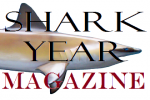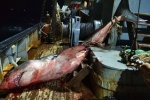Range extension of the Critically Endangered shorttail nurse shark
Range extension of the Critically Endangered shorttail nurse shark Pseudoginglymostoma brevicaudatum (Orectolobiformes: Ginglymostomatidae) to include Mozambique, with implications for management Rhett H. Bennett, David A. Ebert, Jorge J. Sitoe, Stela Fernando, Mark Harris, David van Beuningen, Aseeqah Davids ABSTRACT: The Critically Endangered shorttail nurse shark Pseudoginglymostoma brevicaudatum (Günther, 1866) is a small-bodied Orectolobiform shark found
Future thermal regimes for epaulette sharks
Future thermal regimes for epaulette sharks (Hemiscyllium ocellatum): growth and metabolic performance cease to be optimal Carolyn R. Wheeler, Jodie L. Rummer, Barbara Bailey, Jamie Lockwood, Shelby Vance, John W. Mandelman ABSTRACT: Climate change is affecting thermal regimes globally, and organisms relying on their environment to regulate biological processes face unknown consequences. In ectotherms, temperature
Sandbar shark aggregation in the central Mediterranean Sea
Sandbar shark aggregation in the central Mediterranean Sea and potential effects of tourism C. Cattano, G. Turco, M. Di Lorenzo, M. Gristina, G. Visconti, M. Milazzo ABSTRACT: 1. An aggregation of sandbar sharks Carcharhinus plumbeus occurs every summer around the remote uninhabited islet of Lampione (Pelagie Islands Marine Protected Area, south‐western Mediterranean Sea), attracting an
Metal concentrations in coastal sharks from The Bahamas
Metal concentrations in coastal sharks from The Bahamas with a focus on the Caribbean Reef shark Oliver N. Shipley, Cheng-Shiuan Lee, Nicholas S. Fisher, James K. Sternlicht, Sami Kattan, Erica R. Staaterman, Neil Hammerschlag, Austin J. Gallagher ABSTRACT: Over the last century anthropogenic activities have rapidly increased the influx of metals and metalloids entering the
Seasonal Occurrence, Horizontal Movements, and Habitat Use Patterns of Whale Sharks in the Gulf of Mexico
Seasonal Occurrence, Horizontal Movements, and Habitat Use Patterns of Whale Sharks (Rhincodon typus) in the Gulf of Mexico Eric R. Hoffmayer, Jennifer A. McKinney, James S. Franks, Jill M. Hendon, William B. Driggers III, Brett J. Falterman, Benjamin Galuardi, Michael E. Byrne ABSTRACT: In the northern Gulf of Mexico (GOM), whale sharks (Rhincodon typus) form
U.S. Virgin Islands: Guide to Common Sharks
Press Release The U.S. Virgin Islands Department of Planning and Natural Resources 22. January 2021 —— —– —– —– —– —- Commissioner Jean-Pierre L. Oriol of the Department of Planning and Natural Resources has announced that the Division of Fish and Wildlife has published a new guide to common sharks of the Virgin Islands with
Review of Shark Attacks Off Florida’s Coast, 1960 – 2016
A Biting Review of Shark Attacks Off Florida’s Coast, 1960 – 2016 Chris J. Thompson, Kenneth J. Dieker, Isabel D. Chandler, Jason F. Berger, Paul Martin Sommers ABSTRACT: The authors examine the monthly total and average number of unprovoked shark attacks off Florida’s Atlantic and Gulf coasts between 1960 and 2016, with special emphasis on
First records of the megamouth shark as bycatch in Peruvian small-scale net fisheries
First records of the megamouth shark Megachasma pelagios (Taylor, Compagno & Struhsaker, 1983) as bycatch in Peruvian small-scale net fisheries Acuña-Perales, N., Córdova-Zavaleta, F., Alfaro-Shigueto, J., Mangel, J.C. ABSTRACT: Between October 2018 and October 2019, seven megamouth sharks were reported as bycatch in the small-scale surface and midwater gillnet fisheries operating from the ports of
Coastal sharks and rays in a marine protected area in southern Brazil
Coastal sharks and rays in a marine protected area in southern Brazil Paulo R. S. Santos, Marcelo N. Alves, Magnus M. Severo ABSTRACT: In southern Brazil, we investigated shark and ray capture records in an integral protection marine protection area (MPA) that allows fishing in that area. We found 10 shark and nine ray species,
Bigeye thresher shark movements and post-release survivorship
Bigeye thresher shark Alopias superciliosus movements and post-release survivorship following capture on linked buoy gear Scott A. Aalbers, Michael Wang, Charles Villafana, Chugey A.Sepulveda ABSTRACT: Off the US west coast, fishery development efforts have led to the recent recommendation for authorization of deep-set buoy gear (DSBG) and linked buoy gear (LBG), two commercial gear types
Intergenerational microbial transmission in the little skate
Intergenerational microbial transmission in the little skate (Leucoraja erinacea) Katelyn Mika, Alexander S. Okamoto, Neil H. Shubin, David B. Mark Welch ABSTRACT: Microbial transmission from parent to offspring is hypothesized to be universal in vertebrates. However, evidence for this is limited as many clades remain unexamined. Chondrichthyes, as one of the earliest–branching vertebrate lineages, provide
Phylogenetic significance of clasper morphology of electric rays
Phylogenetic significance of clasper morphology of electric rays (Chondrichthyes: Batoidea: Torpediniformes) Renan A. Moreira, Marcelo R. de Carvalho ABSTRACT: Torpediniformes (electric rays) is a monophyletic group strongly supported by morphological and molecular phylogenetic studies. The claspers of electric rays, however, are poorly documented in comparation to the clasper of other batoids, especially skates, and the
Nov 2020: Great White Shark Caught in Kuril Islands
H. Nickel, Shark Year Magazine, 21. January 2021 In early November 2020, news broke out that Russian fishermen caught a large shark in the Kuril archipelago. The available information is very vague. But according to the source, the catch was made in the waters of Shikotan (an island in the southern Kurils). They shared photos
Environmental DNA can detect bull sharks across a dynamic deltaic interface
Swimming against the flow—Environmental DNA can detect bull sharks (Carcharhinus leucas) across a dynamic deltaic interface James Marcus Drymon, Katherine E. Schweiss, Emily A. Seubert, Ryan N. Lehman, Toby S. Daly‐Engel, Mariah Pfleger, Nicole M. Phillips ABSTRACT: Human activities in coastal areas are accelerating ecosystem changes at an unprecedented pace, resulting in habitat loss, hydrological
Study estimates 200-plus white sharks breed each year
News Release The University of Queensland 23 December 2020 — — — — — — — — — — — A study on the vulnerable white shark has shown that approximately 206 to 252 sharks breed on Australia’s east coast each year. The joint study involving The University of Queensland, NSW Department of Primary Industries and Stellenbosch University in South Africa








